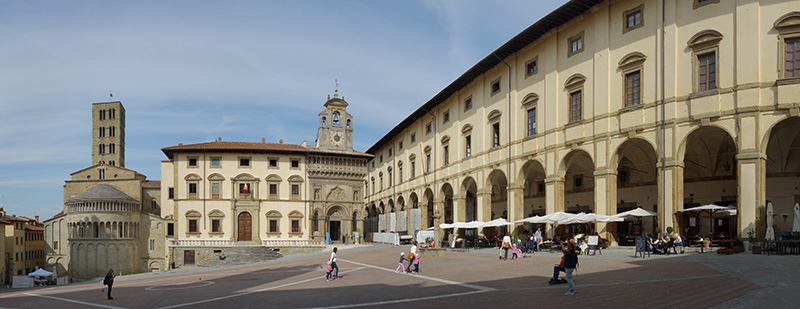
The city of Arezzo, situated in the South-West of Tuscany, rises up a hill which takes in 4 valleys: Valtiberina, Casentino, Valdarno and Valdichiana. The city has deeply historic origins, and is – although this is a little-known fact – even older than Alexandria in Egypt!
Arezzo was one of the major Etruscan Lucumonies and later became a strategic Roman center, a fulcrum of flourishing economic activity and cultural monuments, including the Amphitheater, whose remarkable remains can be seen today. The center of Arezzo is home to magnificent monuments, churches, palaces and museums.
At that time its foundries and art factories, whose decoration technique spread throughout the Roman world for coral vases were renowned. In the Middle Ages, it became a free commune in which the Ghibelline faction prevailed and conflicted with Florence. After the battle of Campaldino in 1289, the independence of the city ended and, despite a slight economic recovery during the Tarlati period, Arezzo became a Florentine domain as early as 1384, thus becoming part of the Grand Duchy of the Medici family.

Arezzo is like a gem suspended in time. It’s a place where the past and the present intertwine in a harmonious dance. Many ilustrious figures were born here, such as Vasari, Piero della Francesca, Guido Monaco, Francesco Redi and Francesco Petrarca.
What to see in Arezzo

In the heart of the historic center it is impossible not to be fascinated by its most famous church, the San Francesco Basilica. Its interior preserves the series of frescoes by Piero della Francesca, the Legend of the True Cross, a Renaissance masterpiece of inestimable value.
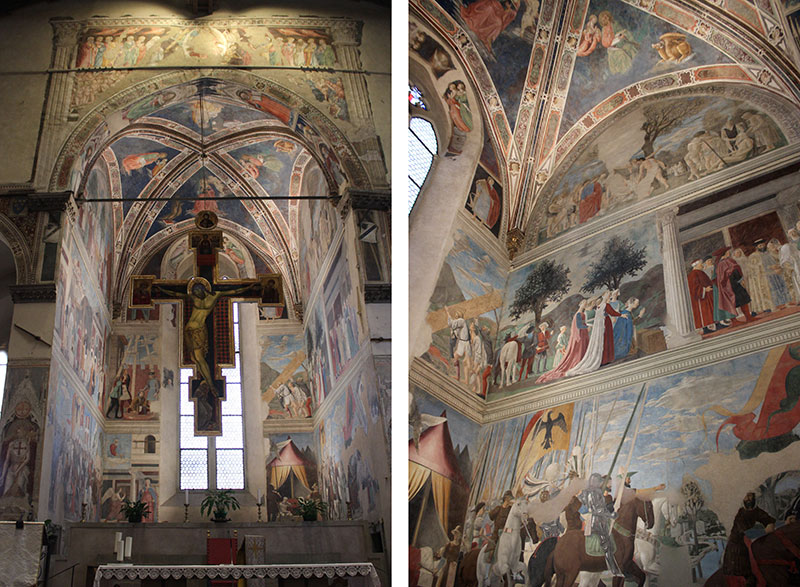
The stained glass windows inside the Cathedral of San Donato by Guillame de Marcillat and the Magdalene by Piero della Francesca are breathtakingly beautiful.
The impressive Loggiato Vasariano stands next to the medieval towers – it was the model for and trial of the one later made by the artist for the Uffizi - which surrounds Piazza Grande or Piazza Vasari. Visits to the Medici Fortress (built by Cosimo I), the Palazzo della Fraternita dei Laici and the Parish church of Santa Maria, one of the best known examples of Romanesque architecture, are unmissable.
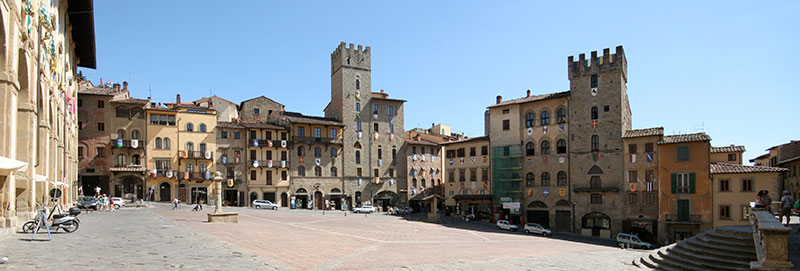
The Palazzo dei Priori, a jewel of art and architecture, is in the heart of the historic center and has now become the Municipal seat. In the medieval village you can also visit the remains of the Roman amphitheater. a wooden crucifix by Cimabue is also kept in the Basilica of San Domenico.
You absolutely cannot miss the Mudas, the Diocesan Museum of Sacred Art of Arezzo, located inside the Palazzo Vescovile. The museum is home to artistic heritage from the Arezzo diocese, the Duomo and other churches in the area. The rooms also showcase paintings from the 15th to the 19th century. We also recommend a visit to the Giorgio Vasari House Museum, dedicated to the painter, architect and sculptor born in Arezzo.
Take your time in Tuscany. Enjoy yourself, contemplate and explore the territory of Arezzo, surrounded by four green valleys. It’s an elegant, lively city. The different ages of antiquity and their splendor can be found in almost everything you see. The charm of vintage enhances your stay in this part of Tuscany which leads you on a journey through time. Slowing down here will be the gift you give to yourself as you eat excellent food, experience events with the locals, listen to stories and discover antiques, all while surrounded by the rolling hills and gurgling rivers. Dedicate your attention to the good things and learn how to listen to your heart. An exclusive, tailored holiday here can help you pamper all your senses.

If you are in Arezzo for a day, we suggest you plan in advance to visit what the city has to offer. The ideal starting point is from the upper old city part. Here, in Piazza San Domenico there is a stone bench waiting for you. Take a seat and let your gaze flow from the fountain to the circumference of the ancient public pit, traced on the red pavement, up to the asymmetrical facade of the church with its sail shaped bell tower.
You will not regret climbing up the hill, on which Arezzo stands, to discover the Cathedral, just a few hundred meters from the Church of San Domenico. The bell tower stands on the Gothic cathedral dedicated to Saints Peter and Donato.
The statue of the Grand Duke of Tuscany Ferdinando I de’ Medici flanks the main facade, which remained unfinished until the twentieth century. After all, it took a couple of centuries to complete the building, built from 1278 to the beginning of the sixteenth century.
Its verticality makes you look up, but every corner of this place deserves your attention. The light from the outside filters through the stained-glass windows, illuminating the fresco of the Magdalen by Piero della Francesca. From the main altar the Ark of Saint Donato honors the memory of the bishop and martyr patron of Arezzo and it guards most of his remains.
As you walk along the left aisle you come across the Chapel of Our Lady of Comfort, protectress of Arezzo; the Virgin appears in a glazed terracotta from the workshop of Andrea della Robbia.
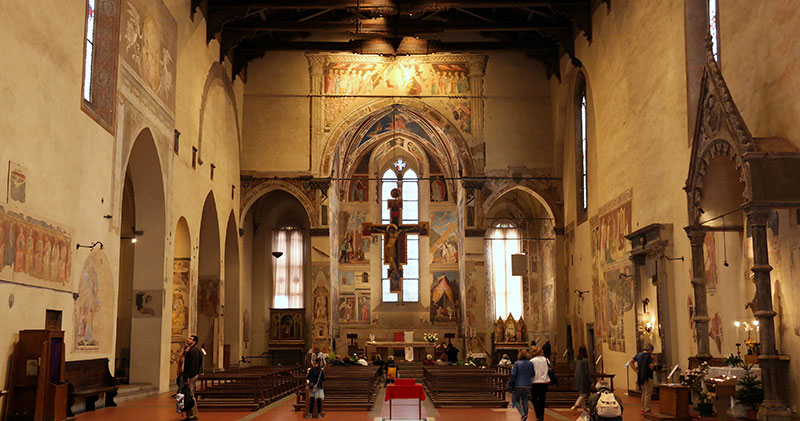
Have you noticed all the different columns supporting the two pulpits of the church? Are you fantasizing about the sounds that the pair of majestic pipe organs make? In its cathedral, Arezzo condenses spirituality, art and centuries of history: it is impossible to remain indifferent.
A day is very little time for visiting Arezzo, so remember that this city is famous in Italy and around the world for one of the most extraordinary works by Piero della Francesca. Book your entrance to the Basilica of Saint Francis to be enchanted by the Bacci Chapel.
From Piazza del Duomo you can easily reach it going downhill along Piazza della Libertà and Via Andrea Cesalpino. The church in simple Gothic style preserves the cycle of frescoes of the Legend of the True Cross. Piero dedicates his eyes and heart to the story inspired by the “Golden Legend” written by Jacopo da Varagine. An unmissable experience in your tour of Arezzo in one day: let yourself be captivated by the artistic narration of the famous Renaissance painter and you will feel like dreaming just like the Emperor Constantine in one of Piero’s scenes.
-wiki.jpg)
Reach the portici of Via Roma, continue on Via Francesco Crispi toward the Parco “Sandro Pertini” and on your right the second century B.C. Roman Amphitheatre of Arezzo appears. Able to accommodate over 10,000 sitting spectators on three separate floors, it was the largest public building in ancient Arretium.The land of its arena was trampled during gladiatorial games and hunts. In 1333 the Southern side of the complex was used to build the Monastery of Monte Oliveto, where today there is the National Archaeological Museum Gaio Cilnio Mecenate. Jewels, votive statuettes, earthen vessels sealed by Arezzo and a 500 B.C. Euphronios Crater are just some of the treasures you must absolutely admire here.
A small break…
Who wants a little shopping? The streets of the old city centre of Arezzo are the ideal place for a walk dedicated to shopping and souvenirs. From the Roman Amphitheatre head towards Corso Italia, the street, which from the area of the railway station to the Vasari Logge, crosses the oldest part of the city.
The shop windows of Arezzo will compete for your attention. From clothing to crafts, from food and wine to antiques indulge in the search for the best purchases. Join the “struscio” of passers-by and give yourself a moment of refreshment in one of the many clubs in the city centre, a small routine pleasure of which the Aretinians are fond.
Three naves and the apse that goes up to the rear part of Piazza Grande, its magnificent Romanesque architecture holds in the shade countless beauties: from a polyptych by Pietro Lorenzetti to the Chapel of SS. Sacramento, the baptismal font and much more. Walk at the bottom of the imposing columns of the Pieve without giving up an overall view from the raised presbytery.
The park Il Prato is the perfect place for a rejuvenating walk. In your visit to Arezzo in one day you will find it next to the Cathedral, going up from Corso Italia in via dei Pileati. Citizens of Arezzo come here to do sports and relax, enjoy a bit of coolness in the summer season and participate in major events of the city calendar such as the September edition of the Antique Fair.
A pine circle framing the marble monument in honor of the poet Francesco Petrarca is located between the Cathedral and the entrance to the Medicean Fortress of Arezzo. It has a star-shaped plan and heart-shaped bastions for the defensive structure (temporarily closed to the public) which replaced the ancient formwork in the Sixteenth century, according to the design of the architects Giuliano and Antonio da Sangallo the Elder.
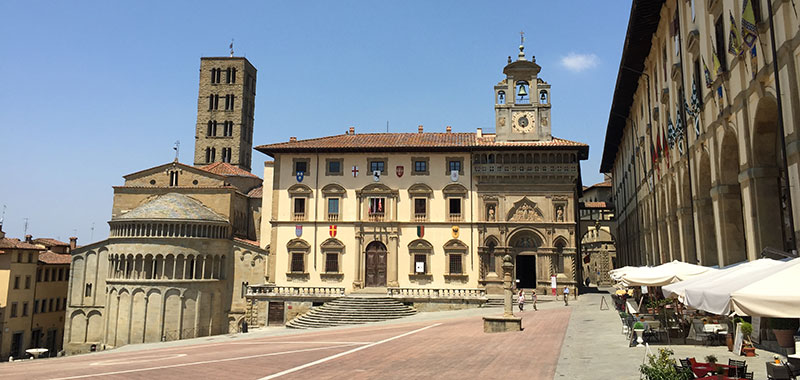
In one day in Arezzo you cannot forget to visit a fundamental place: Piazza Grande, a brief few minutes’ walk in the direction of Corso Italia, behind the apse of the Pieve. The Saracino Joust takes place right here, inside the inclined trapezoid which gathers in a single suggestive picture the pit, the Medieval towers, the Palazzo della Fraternita and the Loggia by Giorgio Vasari. Find the perspective from which you like to look at it, maybe from an outdoor table during the aperitif. Imagine it at sunset, when the sun gives way to the lights of the clubs where you can taste the best of local food and wine.
In front of this show, you will know that if Arezzo in a day is not enough, its beauty will welcome you again whenever you want.
Tour:
Visit to the panoramic terrace of the Ivan Bruschi House Museum
Short stop at the house museum of the creator of the Antiques Fair with the climb to the terraces to admire the facade of the Pieve di Santa Maria which can be visited inside during the interventions.
Visit to the Cathedral of Arezzo. Inside you can admire the Magdalene by Piero della Francesca, the stained glass windows by Guglielmo de Marcillat and the chapel of the Madonna del Conforto.
Visit to the Basilica of San Domenico, a fundamental stop for those who visit Arezzo, an unmissable opportunity to admire the cross painted by Cimabue.Piazza Grande
The tour ends with the beautiful Piazza Grande, the heart of the city, which frames the famous Antiques Fair and the traditional Giostra del Saracino. In this place the tourist will have the opportunity to admire the Vasari Loggia, the Palazzo della Fraternità dei Laici with the spectacular astronomical clock and the medieval towers.
The preceeding information is from the Tuscany Tourist Information website, and the Arezzo Tourist Information website.
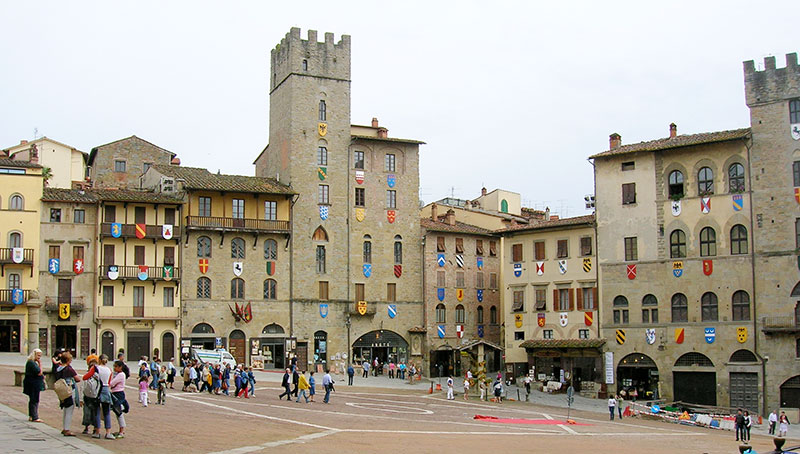
The following information is from Wikipedia on Arezzo:
Arezzo is a city and comune in Italy and the capital of the province of the same name located in Tuscany. Arezzo is about 80 kilometres (50 miles) southeast of Florence at an elevation of 296 metres (971 ft) above sea level. In 2013 the population was about 99,000.
History
Described by Livy as one of the Capita Etruriae (Etruscan capitals), Arezzo (Aritim in Etruscan) is believed to have been one of the twelve most important Etruscan cities—the so-called Dodecapolis, part of the Etruscan League. Etruscan remains establish that the acropolis of San Cornelio, a small hill next to that of San Donatus, was occupied and fortified in the Etruscan period. There is other significant Etruscan evidence: parts of walls, an Etruscan necropolis on Poggio del Sole (still named "Hill of the Sun"), and most famously, the two bronzes, the "Chimera of Arezzo" (5th century BC) and the "Minerva" (4th century BC) which were discovered in the 16th century and taken to Florence. Increasing trade connections with Greece also brought some elite goods to the Etruscan nobles of Arezzo: the krater painted by Euphronios c. 510 BC depicting a battle against Amazons (in the Museo Civico, Arezzo 1465) is unsurpassed.
Roman pottery sherd from Arezzo, Latium, found at Arikamedu in India (1st century AD), an evidence of the role of the city in Roman trade with India through Persia during the Augustan period. Musée Guimet.
Conquered by the Romans in 311 BC, Arretium became a military station on the via Cassia, the road by which Rome expanded into the basin of the Po. Arretium sided with Marius (157 – 86 BC) in the Roman Civil War, and the victorious Sulla (c. 138 – 78 BC) planted a colony of his veterans in the half-demolished city, as Arretium Fidens ("Faithful Arretium"). The old Etruscan aristocracy was not extinguished: Gaius Cilnius Maecenas, whose name has become eponymous with "patron of the arts", came of the noble Aretine Etruscan stock. The city continued to flourish as Arretium Vetus ("Old Arretium"), the third-largest city in Italy in the Augustan period, well known in particular for its widely exported pottery manufactures, the characteristic moulded and glazed Arretine ware, bucchero-ware of dark clay and red-painted vases (the so-called "coral" vases).
Around 261 AD the town council of Arezzo dedicated an inscription to its patron L. Petronius Taurus Volusianus. See that article for discussion of the possible political/military significance of Volusianus's association with the city.
In the 3rd to 4th century Arezzo became an episcopal seat: it is one of the few cities whose succession of bishops are known by name without interruption to the present day, in part because the bishops operated as the feudal lords of the city in the Middle Ages. The Roman city was demolished, partly in the course of the Gothic War and of the late-6th-century invasion of the Lombards, partly dismantled, as elsewhere throughout Europe. The Aretines re-used the stones for fortifications. Only the amphitheater remained.
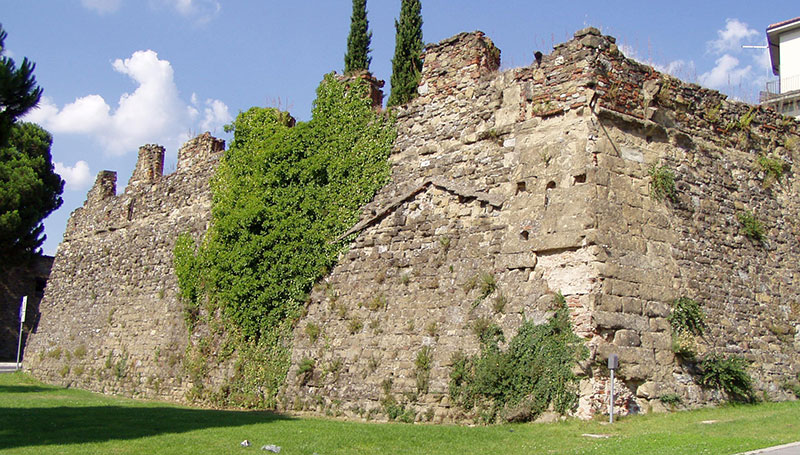
The commune of Arezzo threw off the control of its bishop in 1098 and functioned as an independent city-state until 1384. Generally Ghibelline in tendency, it opposed Guelph Florence. In 1252 the city founded its university, the Studium. After the rout of the Battle of Campaldino (1289), which saw the death of Bishop Guglielmino Ubertini, the fortunes of Ghibelline Arezzo started to ebb, apart from a brief period under the Tarlati family, chief among them Guido Tarlati, who became bishop in 1312 and maintained good relations with the Ghibelline party. The Tarlati sought support in an alliance with Forlì and its overlords, the Ordelaffi, but failed: Arezzo yielded to Florentine domination in 1384; its individual history became subsumed in that of Florence and of the Medicean Grand Duchy of Tuscany. During this period Piero della Francesca (c. 1415–1492) worked in the church of San Francesco di Arezzo producing the splendid frescoes, recently restored, which are Arezzo's most famous works. Afterwards the city began an economical and cultural decay, which ensured the preservation of its medieval centre.
In the 18th century the neighbouring marshes of the Val di Chiana, south of Arezzo, were drained and the region became less malarial. At the end of the-century French troops led by Napoleon Bonaparte conquered Arezzo, but the city soon turned (1799–1800) into a resistance base against the invaders with the "Viva Maria" movement, winning the city the role of provincial capital. In 1860 Arezzo became part of the Kingdom of Italy.
City buildings suffered heavy damage during World War II; the Germans made a stand in front of Arezzo early in July 1944 and fierce fighting ensued before the British 6th Armoured Division, assisted by New Zealand troops of the 2nd New Zealand Division, liberated the town 16 July 1944. The Commonwealth War Graves Commission's Arezzo War Cemetery, where 1,266 men are buried, is located to the north-west of the city.
Pope Benedict XVI visited Arezzo and two other Italian municipalities on May 13, 2012.
Geography
Arezzo is set on a steep hill rising from the floodplain of the River Arno. In the upper part of the town are the cathedral, the town hall and the Medici Fortress (Fortezza Medicea), from which the main streets branch off towards the lower part as far as the gates. The upper part of the town maintains its medieval appearance despite the addition of later structures. Arezzo's city proper is near the high risk areas for earthquakes, but located in a transitional area where the risk for severe earthquakes is much lower than in nearby Umbria and Abruzzo, albeit it is slightly more vulnerable than Florence. Notable earthquakes are still a very rare phenomenon in the province, with a 4.6 quake 25 kilometres (16 mi) to its north-east that claimed no lives on 26 November 2001 the exception.
Piazza Grande
The Piazza Grande is the most noteworthy medieval square in the city, opening behind the 13th century Romanesque apse of Santa Maria della Pieve. Once the main marketplace of the city, it is currently the site of the Giostra del Saracino ("Joust of the Saracen"). It has a sloping pavement in red brick with limestone geometrical lines.
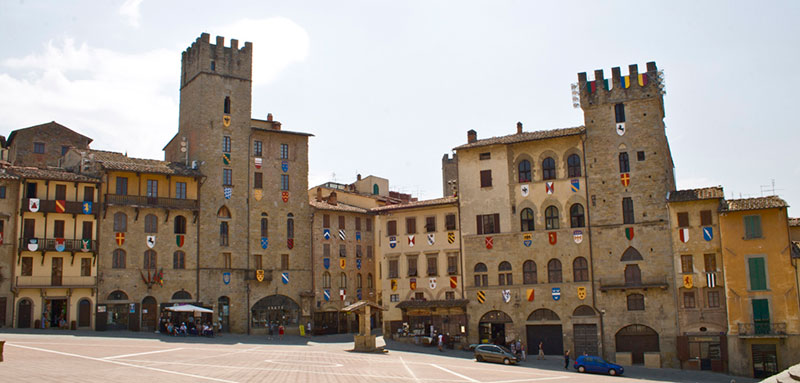
Aside from the apse of the church, other landmarks of the square include: The Palace of the Lay Fraternity (Fraternita dei Laici): 14th–15th century palazzo, with a Gothic ground floor and a quattrocento second floor by Bernardo Rossellino. The Vasari Loggia along the north side, a flat Mannerist façade designed by Giorgio Vasari.
Episcopal Palace, seat of the bishops, rebuilt in the mid-13th century. The interior has frescoes by Salvi Castellucci, Teofilo Torri and Pietro Benvenuti. In front of the Palace is the Monument to Grand Duke Ferdinando I de' Medici (1595), by Pietro Francavilla, following a design of Giambologna. Palazzo Cofani-Brizzolari, with the Torre Faggiolana. Remains of the Communal Palace and the Palazzo del Popolo can also be seen.
Churches
Santa Maria della Pieve: The most striking feature of this Romanesque church is the massive, square-planned bell tower with double orders of mullioned windows. The church was built in the 12th century over a pre-existing Palaeo-Christian edifice, and was renovated a century later with the addition of the characteristic façade made of loggias with small arches surmounted by all different-styled columns. Also from the same century is the lunette with the Virgin between Two Angels and the sculptures of the months (1216) over the main portal. the interior has a nave and two aisles, with a transept also added in the 13th century. In the following century chapels, niches and frescoes were added, including the polyptych of Virgin with Child and Saints by Pietro Lorenzetti (1320). In the crypt is a relic bust of St. Donatus (1346). From the same epoch is the hexagonal baptismal font, with panels of the Histories of St. John the Baptist, by Giovanni d'Agostino. The Pieve was again renovated by Giorgio Vasari in 1560.
Cathedral of Saint Donatus (13th – early 16th centuries): The façade of this Gothic style church remained unfinished, and was added in the 20th century. The interior has a nave and aisles divided by massive pilasters. The left aisle has a fresco by Piero della Francesca portraying the Madeleine. Noteworthy are also the medieval stained glass, the Tarlati Chapel (1334) and the Gothic tomb of Pope Gregory X.
Basilica of San Francesco (13th–14th centuries): Built in Tuscan-Gothic style. Of the projected façade cover in sculpted stone only the lower band was completed. The interior has a single nave: the main attraction is the History of the True Cross fresco (1453–1464) cycle by Piero della Francesca in the Bacci Chapel. Under the church is another Basilica with a nave and two aisles (Basilica inferiore), today used for art exhibitions.
Basilica of San Domenico (founded in 1275 and completed in the early 14th century): The interior has a single nave with a Crucifix by Cimabue, a masterwork of 13th-century Italian art. Other artworks include a Sts. Philip and James the Younger and St. Catherine by Spinello Aretino and other 14th century painting and sculpture decorations.
Santissimi Annunziata
San Michele: This church has a modern façade. Traces of the original Romanesque edifice and the Gothic restoration can be seen in the interior.
Santa Maria in Gradi This medieval church was initially built in the 11th or the 12th century, but reconstructed in the late 16th century by Bartolomeo Ammannati. The interior has a single nave with stone altars (17th century) and a Madonna of Misericordia, terracotta by Andrea della Robbia.
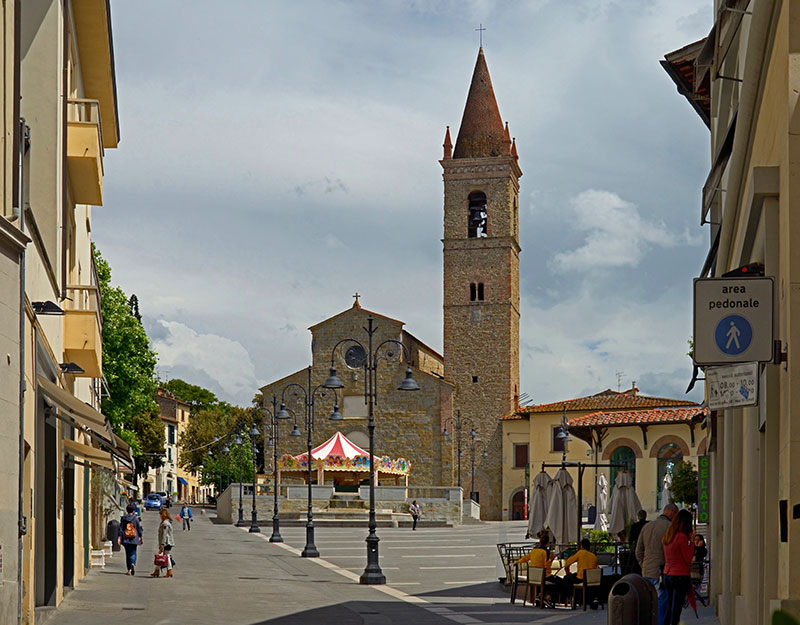
Church of St. Augustine, founded in 1257, modified in the late 15th and the late 18h centuries. The façade and the interior decoration are largely from Baroque times. The square plan bell tower is from the 15th century.
Badia delle Sante Flora e Lucilla (12th century): The abbey was built by Benedictine monks in the 12th century, it was totally restored in the 16th century under the direction of Giorgio Vasari. The octagonal bell tower is from 1650. The interior, in Mannerist style, has an illusionistic canvas depicting a false dome by Andrea Pozzo (1702). There are also a St. Lawrence fresco by Bartolomeo della Gatta (1476) and a Crucifix by Segna di Buonaventura (1319).
San Lorenzo, one of the most ancient of the city, having been built before the year 1000, most likely in Palaeo-Christian times. Rebuilt in the 13th century and restored in 1538, it was totally rebuilt in 1705. The apse exterior is in Romanesque style.
Santa Maria delle Grazie, a late Gothic sanctuary with a Renaissance portal by Benedetto da Maiano (1490). It has also a marble high altar by Andrea della Robbia including a pre-existing fresco by Parri di Spinello (1428–1431). The sanctuary was built over a font dedicated to Apollo, which was destroyed by San Bernardino of Siena in 1428, building an oratory in its place. The church was erected in 1435–1444 and has a chapel entitled to St. Bernardino.
Santa Maria a Gradi (1591), a monastery existing already in 1043. It has a Baroque interior, but with an altar by a collaborator of Andrea della Robbia.
Santissima Trinità: This church was built in 1348, it was totally renovated in 1723–1748 in Baroque style. It houses a 14th-century Crucifix, a banner painted by Giorgio Vasari in 1572, a painting of Noli me tangere by Alessandro Allori (1584) and other artworks.
Santa Maria Maddalena, built in 1561 over a pre-14th century structure. It houses a Madonna with Child (Madonna of the Rose) by Spinello Aretino, visible in the high altar (c. 1525) designed by Guillaume de Marcillat. It is now private property.
Pieve di San Paolo, in San Paolo, erected as Palaeo-Christian baptismal church, rebuilt in the 8th-9th centuries and then rebuilt in Romanesque style in the 13th century. The bell tower is from the 14th-15th centuries. The entire church was again renovated after the 1796 earthquake. It has kept 15th-century frescoes by Lorentino d'Andrea and a cyborium. The transept entrance has granite columns with marble capitals from the 5th century AD.
Pieve di Sant'Eugenia al Bagnoro, in Bagnoro. Documented from 1012, it was one of the most important pievi of the diocese during the Middle Ages. The presbytery area is from the 12th century, while the rest is from the 11th century. The bell tower, partially ruined, stands on one of the three apses.
Pieve di San Donnino a Maiano, at Palazzo del Pero (6th–9th centuries). Documented from 1064, it replaced a Palaeo-Christian baptismal church. The frontal part was rebuilt in the 14th century. The apse has 15th century frescoes and a wooden Madonna with Child from the same age.
Others
Roman amphitheatre and museum.
Palazzo dei Priori, erected in 1333, has been the seat of the city's magistratures until today. The edifice was numerous times restored and renovated; the interior has a court from the 16th century, a stone statue portraying a Madonna with Child (1339), frescoes, busts of illustrious Aretines, two paintings by Giorgio Vasari. The square tower is from 1337.
Medici Fortress (Fortezza Medicea), designed by Antonio da Sangallo the Younger and completed in 1538–1560. It was partly dismantled by the French in the early 19th century.
Palazzo Camaiani-Albergotti (14th century, renovated in the 16th century), with the Torre della Bigazza.
Palazzo Bruni-Ciocchi, Renaissance edifice attributed to Bernardo Rossellino. It is seat of the State Museum of Medieval and Modern Art.
Palazzo Pretorio, which was seat of the People's Captain until 1290. The façade has coat of armas of the captains, podestà and commissaries of the city from 14th to 18th century. Only one of the two original towers remains.
House of Petrarch (Casa del Petrarca).
Casa Vasari (in Via XX Settembre) an older house rebuilt in 1547 by Giorgio Vasari and frescoed by him; now open as a museum, it also contains 16th-century archives. The main rooms were decorated by Vasari in an illusionist manner. the drawing room, where Vasare painted the life journey of an artist, with the artistic virtues protected by the gods of antiquite represented as heavenly bodies, is remarkable.
Festivals
Arezzo is home to an annual international competition of choral singing Concorso Polifónico Guido d'Arezzo (International Guido d'Arezzo Polyphonic Contest)
Arezzo is home to an annual medieval festival called the Saracen Joust (Giostra del Saracino). In this, "knights" on horseback representing different areas of the town charge at a wooden target attached to a carving of a Saracen king and score points according to accuracy. Virtually all the town's people dress up in medieval costume and enthusiastically cheer on the competitors.
From 1986 to 2006 Arezzo was also home to an annual popular music and culture festival, each July, called Arezzo Wave. Publicly funded, it attracts bands of high repute and attendees from all over Europe and North America. It also features literary and film expositions. In 2007 it was replaced by PLAY Arezzo Art Festival, still about rock music, involving local bands. Some artists invited in 2007 and 2008 were: Negrita, Peter Gabriel, Lou Reed, Joan Baez, Ben Harper, Goran Bregovic, Carmen Consoli, Max Gazzè, Peter Brook.
In popular culture
Arezzo has a starring role in Roberto Benigni's film Life Is Beautiful (La vita è bella, 1997). It is the place in which the main characters live before they are shipped off to a Nazi concentration camp.
More information about Arezzo from our archives coming soon.